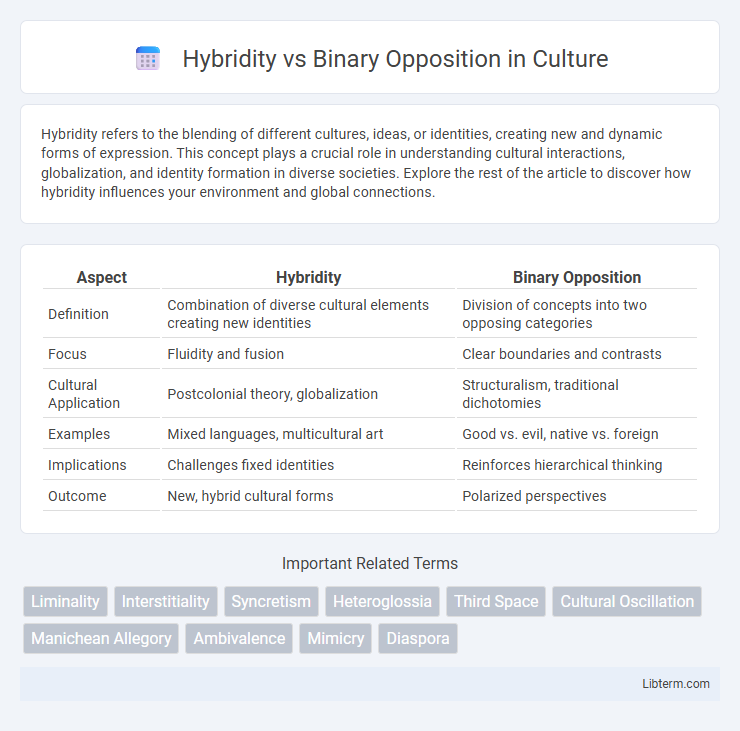Hybridity refers to the blending of different cultures, ideas, or identities, creating new and dynamic forms of expression. This concept plays a crucial role in understanding cultural interactions, globalization, and identity formation in diverse societies. Explore the rest of the article to discover how hybridity influences your environment and global connections.
Table of Comparison
| Aspect | Hybridity | Binary Opposition |
|---|---|---|
| Definition | Combination of diverse cultural elements creating new identities | Division of concepts into two opposing categories |
| Focus | Fluidity and fusion | Clear boundaries and contrasts |
| Cultural Application | Postcolonial theory, globalization | Structuralism, traditional dichotomies |
| Examples | Mixed languages, multicultural art | Good vs. evil, native vs. foreign |
| Implications | Challenges fixed identities | Reinforces hierarchical thinking |
| Outcome | New, hybrid cultural forms | Polarized perspectives |
Understanding Hybridity: Definition and Origins
Hybridity refers to the blending of cultures, identities, and ideas, transcending traditional binary oppositions such as colonizer/colonized or self/other. Originating from postcolonial theory, particularly the works of Homi K. Bhabha, hybridity challenges rigid dichotomies by highlighting the fluid, dynamic nature of identity formation in colonial and postcolonial contexts. This concept emphasizes the interstitial spaces where cultural exchange produces new, hybrid identities that resist fixed categorizations and hierarchical frameworks.
Binary Opposition: Theoretical Foundations
Binary opposition, a foundational concept in structuralist theory, originates from the work of linguist Ferdinand de Saussure and anthropologist Claude Levi-Strauss, who argued that human cognition organizes meaning through pairs of contrasting ideas such as good/evil or light/dark. This theoretical framework posits that these dichotomies structure language, culture, and thought, creating an inherent system of difference that defines concepts relationally. In literary and cultural studies, binary opposition serves as a critical tool for analyzing texts by revealing how meaning is constructed through the opposition of conflicting elements.
Key Differences Between Hybridity and Binary Opposition
Hybridity emphasizes the blending and merging of cultures or ideas, creating new, complex identities that challenge fixed categories. Binary opposition, on the other hand, relies on clear, contrasting pairs such as good/evil or traditional/modern to define meaning through difference. Unlike binary opposition's rigid structure, hybridity fosters fluidity and interaction, undermining the stability of oppositional thinking.
Historical Context: Evolution of Both Concepts
Hybridity emerged from postcolonial theory, particularly through Homi Bhabha's work in the late 20th century, emphasizing cultural blending and identity negotiation in colonial and postcolonial contexts. Binary opposition, rooted in structuralism and developed by scholars like Claude Levi-Strauss in the mid-20th century, frames understanding through paired contrasts such as good vs. evil or colonizer vs. colonized. The evolution of these concepts reflects a shift from rigid dichotomies towards recognizing complexity and fluidity in cultural identities and social hierarchies.
Hybridity in Literature and Cultural Studies
Hybridity in literature and cultural studies challenges fixed binaries by blending diverse cultural identities, languages, and narratives, highlighting the fluidity of meaning and identity. It disrupts traditional binary oppositions such as colonizer/colonized or self/other, enabling a nuanced exploration of postcolonial experiences and transcultural exchanges. This concept foregrounds the transformative potential of overlapping cultural influences, fostering inclusivity and multiplicity within textual and social analysis.
Binary Opposition in Structuralism and Semiotics
Binary opposition in structuralism and semiotics serves as a fundamental framework for analyzing cultural texts by identifying pairs of contrasting concepts, such as good/evil or light/ddarkness. This method highlights underlying structures in language and narratives, revealing how meaning is constructed through difference and opposition. Structuralists argue that these binary pairs are essential for understanding how signs function within cultural systems, influencing interpretation and communication.
Contemporary Relevance of Hybridity
Hybridity challenges the rigid frameworks of binary opposition by highlighting the fluidity and intersectionality of identities, cultures, and ideas in contemporary society. This concept is increasingly relevant in globalized contexts where cultural exchange and fusion foster innovation and resist simplistic dualistic categorizations. Embracing hybridity enables a more nuanced understanding of social dynamics, promoting inclusivity and adaptability in multicultural environments.
Critiques and Limitations of Binary Opposition
Binary opposition, a concept rooted in structuralism, often enforces rigid dichotomies such as good/evil or black/white, which critics argue oversimplify complex social and cultural realities. This framework marginalizes hybrid identities and fluid cultural expressions, failing to acknowledge the interconnectedness and overlap present in contemporary societies. Hybridity challenges these limitations by embracing ambiguity and the coexistence of diverse influences, offering a more nuanced understanding of identity and culture.
Case Studies: Hybridity vs Binary Opposition in Practice
Case studies in cultural and literary analysis reveal hybridity as a dynamic framework that transcends the limiting structures of binary opposition by blending identities, cultures, and meanings into fluid, intersecting forms. For example, postcolonial texts such as Salman Rushdie's "Midnight's Children" illustrate hybridity by merging Indian and British cultural elements, challenging rigid colonial dichotomies and highlighting complex identity formations. In contrast, binary opposition tends to simplify cultural narratives into opposites like colonizer/colonized or East/West, which can obscure the nuanced realities of hybrid experiences demonstrated in these empirical studies.
Future Directions: Bridging Hybridity and Binary Thinking
Future directions in cultural and critical theory emphasize integrating hybridity with binary opposition to foster more nuanced analytical frameworks. By bridging hybridity's fluidity with binary thinking's structural clarity, scholars can develop more dynamic models that better reflect complex social identities and power relations. This synthesis promotes interdisciplinary approaches, enhancing the understanding of cultural overlap and conflict in increasingly globalized contexts.
Hybridity Infographic

 libterm.com
libterm.com